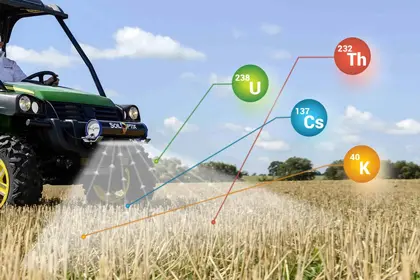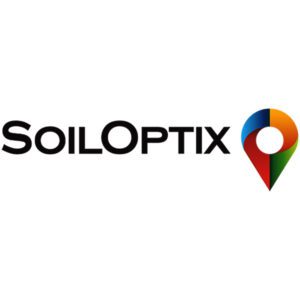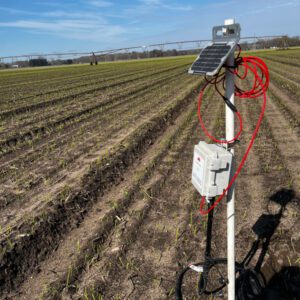
Local experts support grower commitment to daily irrigation water management
Local experts support grower commitment to daily irrigation water management
Many tree fruit and veggie growers in the Pacific Northwest are fortunate to have a sufficient water supply, especially when so many parts of the U.S. are facing moderate to severe drought conditions. But the luxury of having water can lead to the damaging effects of overwatering. And increasing temperatures in the area call for more watering, which further complicates the situation. What is a grower to do?
“Technology is key to efficiency and efficacy,” said Curtis Pusey, irrigation water management specialist, Wilbur-Ellis Agribusiness. “The most important decision a grower can make when developing an irrigation plan is to use a monitoring tool that helps determine when, where and how much water should be applied.”
The second most important practice is to ensure someone on the farm is reviewing the data daily and making the management decisions needed to optimize the grower’s crop and return, explained Paolo Sanguankeo, technology development specialist, Wilbur-Ellis Agribusiness.
“Soil moisture monitoring technology provides growers with insights to their soil’s plant available water, so they can in turnmanage the length and frequency of irrigation events, conserve rootzone nutrients, grow healthy trees and optimize numbers of marketable fruit,” said Sanguankeo. “But if the grower, or someone on their team, isn’t acting on that information in a timely manner, then tree health and crop quality may be at risk.”
Working within a comprehensive team of agronomists, crop consultants, field technology experts, water management specialists and more, Sanguankeo and Pusey partner with tree fruit and veggie growers in Washington state to improve their irrigation water management.
“We handle the installation, maintenance, grower training and data integrity of relevant technologies like Probe Schedule® soil moisture probes and SoilOptix® soil maps—meaning we make sure the soil moisture probes are calibrated, functioning properly and transmitting data that is of high quality. And depending on the grower’s needs, we’ll break down or translate the data in as simple or complex a way as preferred.”
It is ultimately still the grower’s responsibility to water and regularly review the data, but the Wilbur-Ellis team offers continued support to interpret data and provide recommendations based on the results.
Why irrigation management technology?
Tree fruit and veggie growers in the Pacific Northwest are turning to irrigation management technology to help them understand the optimal soil moisture levels for their crop and how that information can help them create ideal growing conditions, raise better crops and get better returns.
“It has been a long-standing practice in tree fruit, for example, to irrigate on a set schedule to give the crop plenty of water,” said Sanguankeo.
But the reality is soil can only hold so much water—and more water is sometimes applied than necessary.
“Probably the best incentives for growers to be more efficient with water are the potential cost savings and more marketable yields,” he said. “Technology helps to conserve water, keep nutrients in the root zone, regulate tree vigor and improve crop quality—supporting stronger, healthier trees that produce better fruit at harvest.”
Having too much water at harvest can result in bruising and storage problems. And if fruit doesn’t store well, it won’t pack well or deliver a good return.
Relevant technologies and how they work.
SoilOptix helps growers in the Cascades map their orchards before and after planting to make the most informed decisions to maximize the return on their crop. The topsoil analysis system uses gamma radiation-based sensor data in combination with strategically placed physical soil samples to give growers an in-depth look at their soil with high-definition nutrient and texture maps.

“SoilOptix shows the physical properties of the soil—clay, sand, silt, loam and organic matter—as well as the nutrition levels, available plant water and fertility,” said Sanguankeo. The physical properties help determine how well the soil pulls water and holds nutrients while the nutrient maps help growers identify weak or under-performing areas that need improvement.
“Those under-performing areas are where our consultants work with growers to install soil moisture probes to determine if more frequent irrigation is necessary—and/or if a targeted application of mulch or compost can be made to help reduce soil surface evaporation, moderate soil surface temperature and improve soil health around the rootzone,” said Sanguankeo.
SoilOptix requires at least three soil samples per field to collect data for analysis by a local lab; visual map results are typically delivered 3-4 business days after the lab produced the results.
“Both SoilOptix and Probe Schedule take the guess work out of soil analysis and irrigation water management,” said Pusey. “They help growers precisely define variation in soil properties so they can make adjustments to help each field reach its full potential.”
Probe Schedule uses soil capacitance meters installed at different depths of the soil profile to monitor soil moisture levels, identify issues and ultimately, help improve crop uniformity. Data is collected and delivered once an hour through a telemetry unit and corresponding software that can be accessed by a phone, tablet or computer. The tool helps growers determine the exact level of water in the soil so they can apply the precise amount needed to avoid over- or under-watering.
“With this technology, growers can conserve water, ensure nutrients stay within the root zone and avoid overspending on water in areas where water isn’t needed,” Pusey added.
“You can guess by looking at the top of soil if you need to water or not. But when you have a look underneath the soil using these probes, you can see the effect of irrigation and he exact amount of water in the soil,” said Pusey.
“Whether your goal is to prevent over-watering or to conserve water because of scarcity and tightening regulations, soil moisture monitoring technologies can help achieve your goals and improve your overall crop quality and yield,” Pusey concluded.

Local support from experienced experts.
Wilbur-Ellis understands that growers have access to a vast array of tools, technologies and information—but that they are also entwined with numerous other aspects of the farming operation and might overlook the importance of frequently monitoring data outputs to get the most from these important resources.
“Since we are gathering real-time data, the grower really does need to ensure someone is watching the soil moisture sensors to notice the effect of irrigation as it is happening,” said Sanguankeo. “That could even be one of our crop consultants; some of them watch the data more than the grower does!”
Beyond the walls of its ag retail locations, Wilbur-Ellis agronomists and consultants provide the relevant technical expertise and hyperlocal knowledge to best enhance the grower’s commitment to long-term success.
“We really provide a full spectrum of on-farm solutions to help growers overcome some of today’s toughest challenges,” said Sanguankeo. “With irrigation water management technology, we often find that growers—even those who are initially hesitant to use the tools—increase their trust in the technology, their soil, water usage and crop quality given the accuracy, efficiency and efficacy they deliver.”
To learn more about Probe Schedule, SoilOptix and other technologies and services, connect with your local Wilbur-Ellis representative or retailer.
Header image courtesy of SoilOptix.

